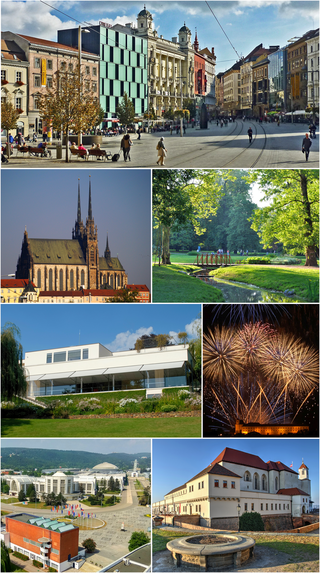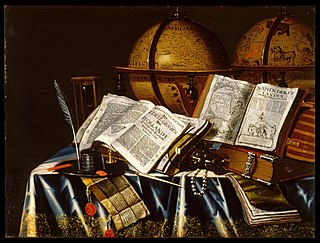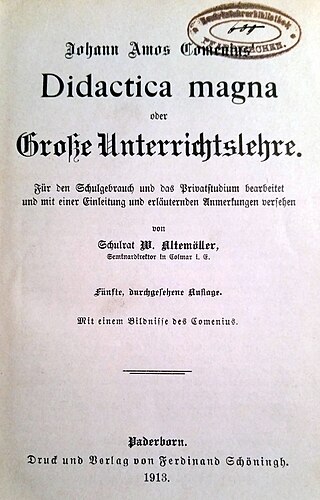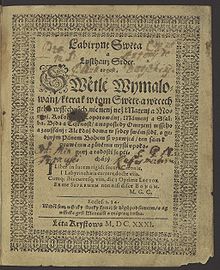
Jewish eschatology is the area of Jewish theology concerned with events that will happen in the end of days and related concepts. This includes the ingathering of the exiled diaspora, the coming of the Jewish Messiah, the afterlife, and the resurrection of the dead. In Judaism, the end times are usually called the "end of days", a phrase that appears several times in the Tanakh.

Brno is a city in the South Moravian Region of the Czech Republic. Located at the confluence of the Svitava and Svratka rivers, Brno has about 400,000 inhabitants, making it the second-largest city in the Czech Republic after the capital, Prague, and one of the 100 largest cities of the European Union. The Brno metropolitan area has approximately 720,000 inhabitants.

A pilgrim is a traveler who is on a journey to a holy place. Typically, this is a physical journey to some place of special significance to the adherent of a particular religious belief system. In the spiritual literature of Christianity, the concept of pilgrim and pilgrimage may refer to the experience of life in the world or to the inner path of the spiritual aspirant from a state of wretchedness to a state of beatitude.

John Amos Comenius was a Moravian philosopher, pedagogue and theologian who is considered the father of modern education. He served as the last bishop of the Unity of the Brethren before becoming a religious refugee and one of the earliest champions of universal education, a concept eventually set forth in his book Didactica Magna. As an educator and theologian, he led schools and advised governments across Protestant Europe through the middle of the seventeenth century.

The Pilgrim's Progress from This World, to That Which Is to Come is a 1678 Christian allegory written by John Bunyan. It is regarded as one of the most significant works of theological fiction in English literature and a progenitor of the narrative aspect of Christian media. It has been translated into more than 200 languages and has never been out of print. It appeared in Dutch in 1681, in German in 1703 and in Swedish in 1727. The first North American edition was issued in 1681. It has also been cited as the first novel written in English. According to literary editor Robert McCrum, "there's no book in English, apart from the Bible, to equal Bunyan's masterpiece for the range of its readership, or its influence on writers as diverse as William Hogarth, C. S. Lewis, Nathaniel Hawthorne, Herman Melville, Charles Dickens, Louisa May Alcott, George Bernard Shaw, William Thackeray, Charlotte Bronte, Mark Twain, John Steinbeck and Enid Blyton." The words on which the hymn "To be a Pilgrim" is based, come from the novel.

Vanity is the excessive belief in one's own abilities or attractiveness to others. Prior to the 14th century, it did not have such narcissistic undertones, and merely meant futility. The related term vainglory is now often seen as an archaic synonym for vanity, but originally meant considering one's own capabilities and that God's help was not needed, i.e. unjustified boasting; although glory is now seen as having a predominantly positive meaning, the Latin term from which it derives, gloria, roughly means boasting, and was often used as a negative criticism.

Petr Chelčický was a Czech Christian spiritual leader and author in the 15th century Bohemia, now the Czech Republic. He was one of the most influential thinkers of the Bohemian Reformation. Petr Chelčický inspired the Unitas Fratrum, who opposed transubstantiation and monasticism, insisting on pacifism and the primacy of scripture. There are multiple parallels with the teachings of the Anabaptists and Petr Chelčický. Czech Baptists have also expressed continuity with the Bohemian reformation by identifying with Petr Chelčický.

Moravian University is a private university in Bethlehem, Pennsylvania. The institution traces its founding to 1742 by Moravians, descendants of followers of the Bohemian Reformation under John Amos Comenius. Founded as a girls school in 1742, the College itself was founded as the Moravian College and Theological Seminary in 1807 and was accredited in 1863. In 2021, the College was elevated to a University. Moravian University uses the foundation of the Girls school as their foundation date which would make them the sixth-oldest college in the United States.

The Moravian Church, or the Moravian Brethren, formally the Unitas Fratrum, is one of the oldest Protestant denominations in Christianity, dating back to the Bohemian Reformation of the 15th century and the Unity of the Brethren founded in the Kingdom of Bohemia, sixty years before Luther's Reformation.

Uherský Brod is a town in Uherské Hradiště District in the Zlín Region of the Czech Republic. It has about 16,000 inhabitants. The historic town centre is well preserved and is protected by law as an urban monument zone.
Petr Eben was a Czech composer of modern and contemporary classical music, and an organist and choirmaster.

Přerov is a city in the Olomouc Region of the Czech Republic. It has about 42,000 inhabitants. It lies on the Bečva River. In the past it was a major crossroad in the heart of Moravia in the Czech Republic. The historic city centre is well preserved and is protected by law as an urban monument zone.

Strážnice is a town in Hodonín District in the South Moravian Region of the Czech Republic. It has about 5,400 inhabitants. The historic town centre is well preserved and is protected by law as an urban monument zone.

Herrnhaag was a communal spiritual centre for the Moravian Unity, an early form of Protestantism. It and Marienborn, a nearby sister community, are located in the Wetterau, an area of Hesse, north of Frankfurt am Main in Germany.

Janua linguarum reserata is a textbook written by John Amos Comenius in 1629. It was published in 1631 in Leszno and was soon translated into most European languages.

The Mladečské Caves are a cave complex in the municipality of Mladeč in the Czech Republic. It is located in the Třesín National Nature Monument within the Litovelské Pomoraví Protected Landscape Area.

Milan Ressel was a Czech painter, printmaker, illustrator and restorer.

Jano Köhler was a Czech painter. He is known for decorating sacral buildings with frescoes and sgraffiti.

The Great Didactic or, full title, The Great Didactic, The Whole Art of Teaching all Things to all Man, is a book written by Czech philosopher, pedagogue and theologian, John Amos Comenius between 1627 and 1638 and first published in 1657.
Comeniology or Comenius studies is the academic discipline dedicated to the comprehensive study of the life, contributions, and educational philosophy of John Amos Comenius (1592–1670). Hailing from Moravia, Comenius was not only an educator but also a prominent philosopher and theologian. His enduring influence has secured him a significant place in the annals of education, making him one of the most pivotal figures in the history of education and pedagogy.


















